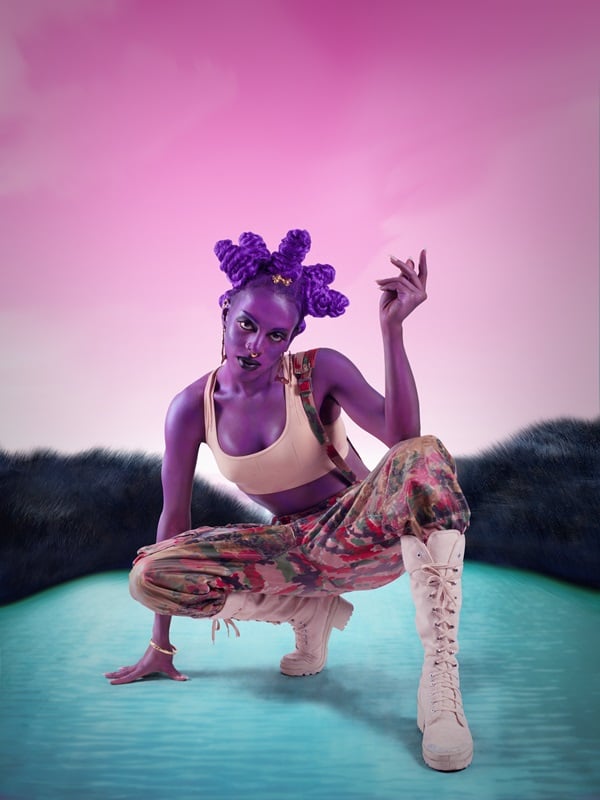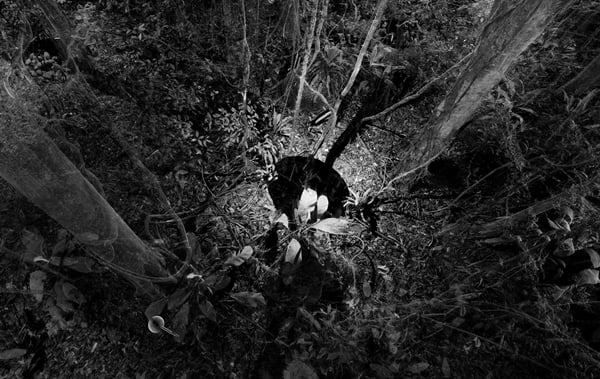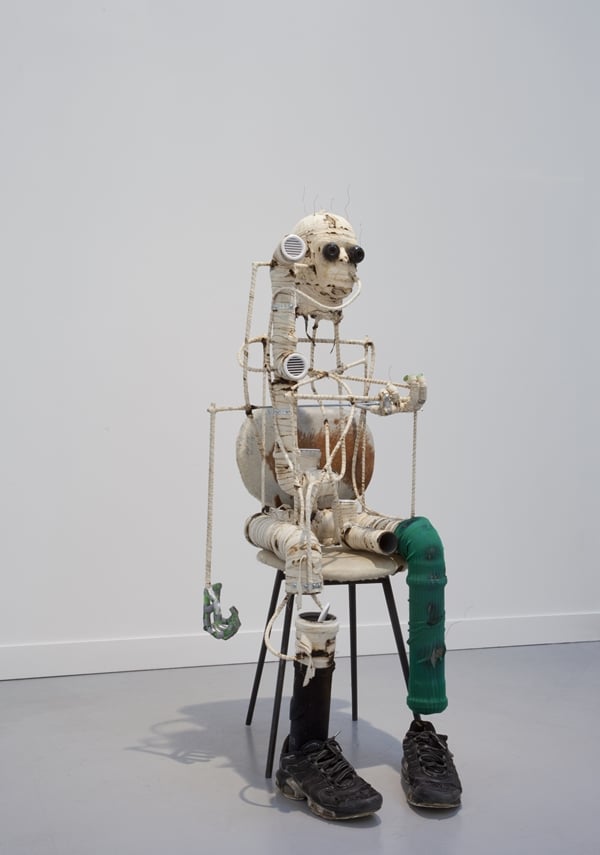Art & Exhibitions
The New Museum Triennial Offers a Dazzling and Dystopian Vision of the Future
The show is governed by a hipster sci-fi aesthetic.

The show is governed by a hipster sci-fi aesthetic.


The figure is back. This, according to New Museum’s Triennial “Surround Audience,” which offers a near-deafening obsession with the self, is its main thesis. Curated by Lauren Cornell and artist Ryan Trecartin, the exhibition takes a look at how technology affects us, a focus that mercifully puts a plug in New York’s seemingly endless supply of non-objective abstraction.
And by the looks of the Triennial, the results of such self-obsession are pretty good. Bold monumental portraits tower over the second floor galleries, while exaggerated interpretations of the present and dystopian trippy visions of the future permeate the show. Activism is everywhere. This is what a strong show looks like.
Certainly, the best example of this is Josh Kline’s Freedom (2015) an installation modeled after Zuccotti Park, the one-time site of Occupy Wall Street. In it, life-sized SWAT team police dolls carry iPads on their bellies—each containing a video showing a social media commenter who has had his or her face overlaid with facial recognition software. Their scripts—found internet clippings—are read by retired police officers.
It’s a thoughtful touch that reflects the reality of social media. In the same way that the voice reading Kline’s script will remain anonymous until the wall label is read, Twitter and Instagram users often don’t know the background of fellow users without a little research. Often that research never gets done, which is why the imperfectness of Kline’s facial recognition software makes so much sense. The construction of identity online isn’t so much incorrect, as it is incomplete.
Behind these figures is a projection of what appears to be President Obama giving the State of the Union address. As with the social media commenters, his face is reconstructed too, and the speech is orated not by Obama, but by the world’s most famous Obama impersonator. The President, here, is transformed into a mere puppet; his words a transparent illusion of freedom, hope, and change.
That sentiment feels pervasive in “Surround Audience” and given its focus on technology and social media, that’s no surprise. Good news rarely makes headlines. This focus, combined with that of the body, may also explain why so many interactive works stood out. DIS Magazine’s installation The Island (KEN) (2015), a functioning shower bed done in collaboration with Dornbracht (a manufacturer of high-end bathroom and kitchen fixtures), promises plenty of foot traffic. During the press preview, a woman in office-wear took a shower fully clothed as part of the performance. An attractive kid in brandless jogging pants mopped up the mess. Points to DIS for creating a spectacle out of this vision of capitalism gone awry, but how about pitching a way out of this hell hole? Living in said system is absurd enough.
A more successful interactive work is Daniel Steegmann Mangrané’s Phantom (2015), which uses the wearable headset, Oculus Rift, to create an immersive virtual Brazilian rainforest (see Have You “Rifted” at the New Museum Triennial?). Though the piece doesn’t comment directly on the current drought in Brazil, which is the worst it’s seen in over 100 years, the situation nonetheless feels relevant. With the headset on, you feel a total loss of control; you can’t see the gallery walls in front of you—only the “forest”; and there’s no way to take a picture of what you see. Does the headset offer a new vision, or a fading memory? Any interpretation feels right.

Daniel Steegman Managrané, Phantom (2014).
Photo: Courtesy artist and New Museum.
Meanwhile, up on the third floor, three enclosed bunker-like structures by Nadim Abbas’s titled Chamber 664 “Kubrick,” Chamber 665 “Spielberg,” and Chamber 666 “Coppola,” showcase interior spaces cordoned off with Plexiglas. Each has a set of four heavyweight black neoprene gloves stitched into the glass, two of which lead inside the bunker so viewers can fondle small toys that look like molecules, toilet paper, and plants. The other pair of gloves, likely for the hands of an imagined resident or, perhaps, an Ebola victim, lead to the outside world. After reaching into a bunker to unroll a large amount of toilet paper, I immediately turned my attention to the outward facing gloves beside me; they needed to be pushed back into the bunker. That automatic impulse reminded me how primal the desire to explore is—no matter how mediated the experience.
If Abbas sees the act of learning about ourselves as one achieved through experience, Frank Benson sees the job through the lens of representation. Taking the award for the most aggrandizing monument to the figure is Benson’s Juliana (2015), a hyperreal nude sculpture of artist and nightlife queen Juliana Huxtable; her blue nails and silky copper skin glitter under the museum lights. Adjacent to this hangs Huxtable’s own Photoshopped self-portraits and poetry, thus deepening the sculptural portrayal. Her skin is green in one picture and purple in another. The poems describe a place in Harlem and the Bronx, beyond the reach of GPS software, where crack pipes burn and “Reparations are taken as they are lived.” Unseen misery takes its toll.
Work like this makes some of the misses in this show feel extra shallow. Eva Kotatkova, for example, “addresses the physical and mental constraints that limit the body” by literally standing inside shaped cages for her installation Not How People Move But What Moves Them (2013). José León Cerrillo’s The New Psychology (2014), house-sized rectangular colored sculptures in aluminum are supposed to draw “upon the legacy of modernism,” but they merely repeat it. And Eloise Hawser’s work Untitled (2014) work explores old printing technology, manufacturing, and the modernist idea of progress through the tedious process of crushing a bunch of old lithographic plates into a single aluminum cube.
These works, though, were ultimately outliers in a show defined by needling work. For me, the best of that came last. After spending my morning at the museum, I decided to finish my viewing with a tour orchestrated by Figian artist Luke Willis Thompson. Going into it, I knew nothing except that the piece would last an hour; the engraved cement slabs, which are outside the museum and are part of the work, give, simply, the logistical details: “Viewing requires a Metrocard 2015.”
“He won’t talk to you,” I was told as three of us (all women) embarked on the tour, which was given by Justin Allen, a black performer. Our only instruction was to follow him. The performer did not seem to want a crowd of women following him. He took sharp turns as if to lose us, nervously looked back at us to see if we were following him, and often jaywalked. I felt terrible that a piece like this needs to exist, but it implicates my own privilege. By the time we got on and off the train, I was at St. Lawrence Ave. in the Bronx. Only one other audience member remained. Willis Thompson dropped us off in front of a church, told us the performance was done, and walked off without a word.

Renaud Jerez, B (2014).
Photo: courtesy the artist and New Museum.
For more news on the New Museum see Palestinian Artist Barred from Attending New Museum Show.